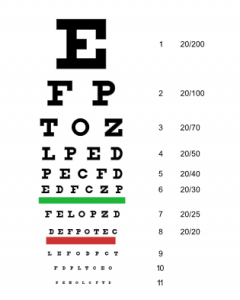

From https://www.yoursightmatters.com
With a large number of states beginning the school year earlier, August is the new September! Along with school supply shopping and purchasing those back-to-school clothing items, it’s time to make comprehensive eye exam appointments for the kids. Conveniently, August is designated as Children’s Eye Health and Safety Month!
A good rule of thumb is to have your children’s eyes examined during well-child visits, beginning around age three. Your child’s eye doctor can help detect refractive errors such as nearsightedness, farsightedness and astigmatism as well as the following diseases:
- Amblyopia (lazy eye)
- Strabismus (crossed eyes)
- Ptosis (drooping of the eyelid)
- Color deficiency (color blindness)
If you or your doctor suspects that your child may have a vision problem, you can make an appointment with your local ophthalmologist for further testing. There are some specific warning signs that may indicate that your child has a vision problem. Some of these include:
- Wandering or crossed eyes
- A family history of childhood vision problems
- Disinterest in reading or viewing distant objects
- Squinting or turning the head in an unusual manner while watching television
Keeping your children’s eyes safe is another part of maintaining healthy vision. Eye injuries are the leading cause of vision loss in children. There are about 42,000 sports-related eye injuries every year in America, and children suffer most of these injuries. Help prevent your child from being one of the more than 12 million children who suffer from vision impairment by remembering a few basic rules of safety:
- All children should wear protective eyewear while participating in sports or recreational activities
- Purchase age-appropriate toys for your children and avoid toys with sharp or protruding parts (Source: HAP).
Help your children have a successful school year by scheduling a comprehensive eye exam and taking safety measures to ensure their eyes are free from injury.
Why is an Eye Exam so Important?
Many of us believe that if we can see well, we don’t need to visit an eye doctor. While good vision is clearly important, an eye exam does more than just test your vision. In fact, your eyes can be portals that offer a glimpse of your overall health. In fact, many diseases show early signs in the eyes, including cardiovascular health and diabetes. So a comprehensive eye exam can help you at any age:
- Vision and learning are closely linked. Children don’t know what ‘normal’ vision is like, so they may not know to complain. Children’s eyes change rapidly as they grow, so eye care is important.
- Around the age 40, most of us have difficulty reading due to Presbyopia. A natural part of the aging process, presbyopia makes it harder to read small print. Computer monitors become more challenging as well. While “drugstore readers” may help, your eye doctor offers a range of options to fit your lifestyle.
- Many eye diseases, including glaucoma and diabetic retinopathy, have no symptoms in the early stages. If left untreated, the vision loss is usually irreversible. Seeing your eye doctor on a regular basis can protect your vision through early treatment.
A comprehensive eye exam, offered only by an ophthalmologist or optometrist, looks at both eye health as well as your vision. Your doctor will check for:
- Refractive error: nearsighted, farsighted or astigmatism
- Focusing problems, including presbyopia
- Other vision problems, such as strabismus, amblyopia or binocular vision
- Eye diseases, such as glaucoma and diabetic retinopathy
- Other diseases, such as high blood pressure or high cholesterol, can often be detected in an eye exam
While tests will vary based on your doctor and your medical history, most comprehensive eye exams include the following:
- Visual Acuity to assess the sharpness of your vision, usually using the “Big E” or Snellen chart.
- Visual fields test, to determine if you have blind spots or peripheral vision issues.
- Cover Test, which can identify strabismus or binocular vision problems.
- Retinoscopy, autorefractor or aberrometer, to approximate your eyeglass prescription.
- Refraction, to fine tune the final eyeglass prescription using a phoropter.
- Slit Lamp exam to detect common eye diseases and conditions. The instrument allows your doctor to examine the structure of your eye to assess its health.
- Glaucoma test, known as tonometry, measures the pressure within your eye.
- Dilation of the pupil and ophthalmoscopy to examine the optic nerve, retina and blood vessels.


